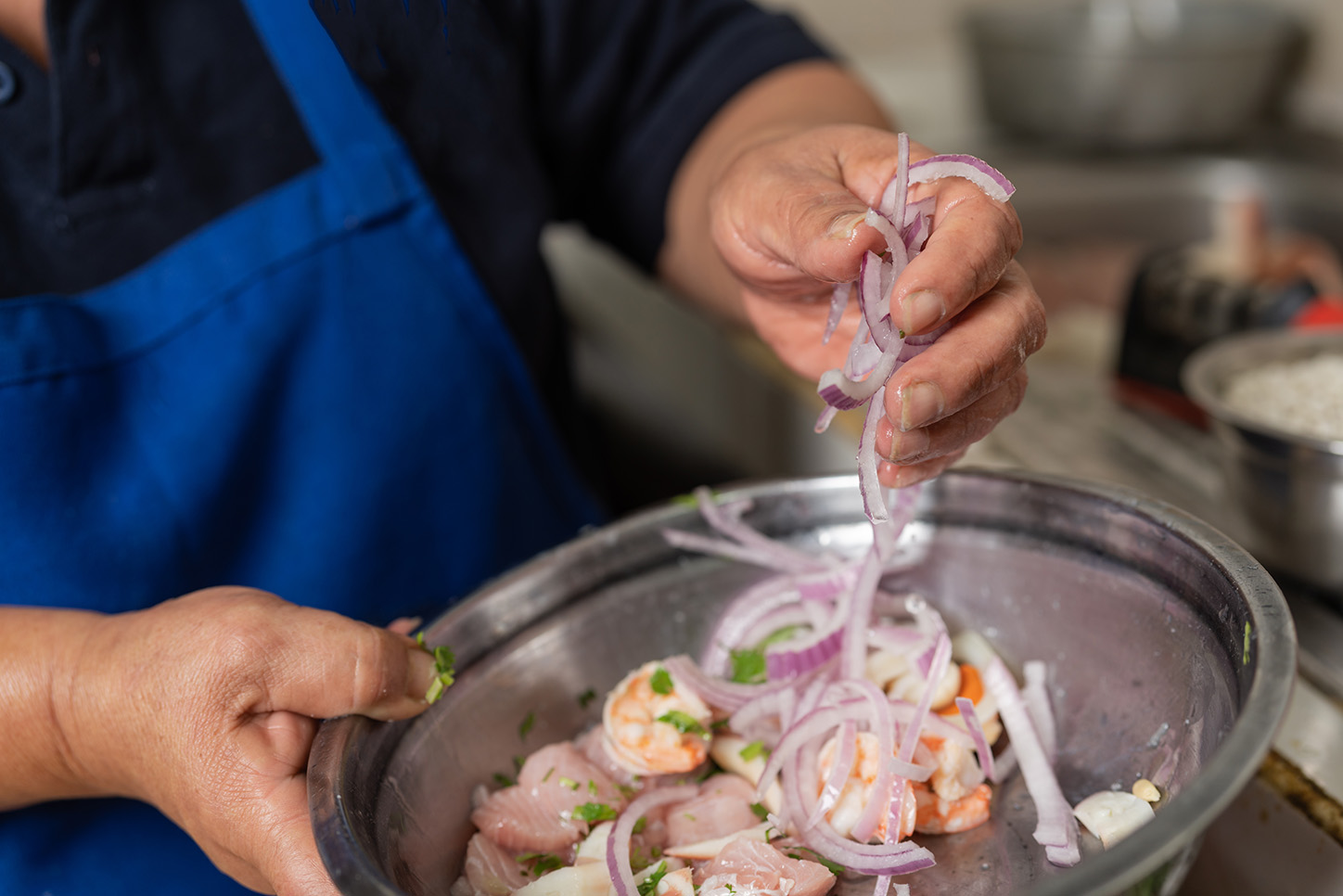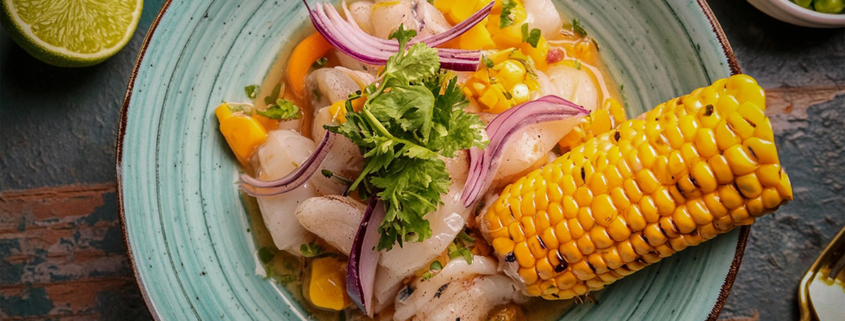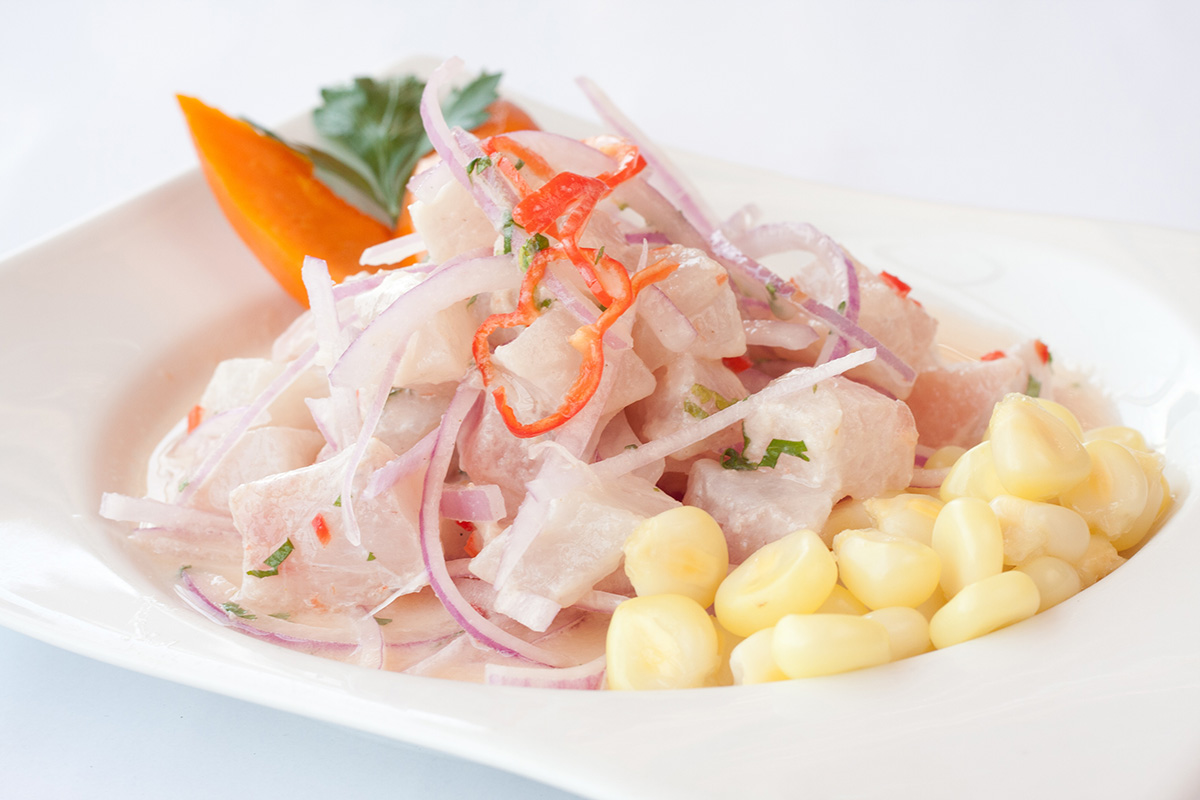Ceviche, The Ultimate Peruvian Dish
In 2023, UNESCO officially inscribed “ceviche” on The Representative List of the Intangible Cultural Heritage of Humanity. The list names cultural traditions and arts important to humanity’s heritage—those worth protecting and preserving on an international level.
The inscription defines ceviche as, “a traditional dish in Peru prepared with raw fish marinated in lemon, seasoned with chili pepper and salt and accompanied with locally grown produce.” UNESCO goes on to describe ceviche’s cultural and culinary importance in Peru—and well beyond its borders.
In fact, the dish is so widely beloved that, in 2025, the Peruvian Nikkei cuisine restaurant Maido ranked as the #1 Best Restaurant In The World. Maido’s rising star can be credited to one much-praised offering: chef Mitsuharu “Micha” Tsumura’s phenomenal ceviche tasting menu.
What makes ceviche so great? Discover the culture, culinary art, and history of the ultimate Peruvian dish.
What Makes Ceviche The Most Iconic Peruvian Dish?
The short answer is, the National Institute of Culture of Peru, part of the government’s Ministry of Education, made ceviche officially Peru’s national dish in 2004.
Yet, the truer answer is ceviche has been an iconic part of Peruvian culture for centuries and generations. It’s eaten in almost every household, both on special occasions and for day-to-day meals.
Almost every town has at least a few popular Cevicherías (or, cebicherias), and many Peruvian chefs are recognized for their takes on the traditional recipe. It’s deceptively simple, flavorful, and available in abundant variations—traits making it a dish beloved by the people of Peru.
How Is Ceviche Traditionally Made?
Traditionally, ceviche has four elements.
1. Fresh-caught, raw white fish
a. Iconically, the fish is sea bass or halibut, cut into small, firm cubes.
2. Citrus fruit marinade (or, a marinade of fruits with similarly acidic juices)
a. Popular fruit juices include lime, bitter orange, lemon and grapefruit.
b. More rarely, passionfruit, aji amarillo chilis, mandarins, and other fruit juices are mixed in.
3. Chili and salt preservative mixture
a. The mixture is added to the marinade to cure the fish
b. Optionally, garlic or cilantro are added.
4. Accompaniments
a. Traditionally the fish is served on a bed of sliced onions, sweet potato, and Peruvian corn (choclo).
b. Rich “tiger’s milk” broth, fish bone broth, or cancha (toasted corn nuts) are also popular sides.
These elements can be changed up to introduce new flavors, or adapt to agriculture or ecological changes.

What Does Ceviche Taste Like?
The taste of ceviche varies depending on which ingredients are used to make it. Yet, the dish’s surprising lightness is a recurring theme.
In a piece for Hakai magazine, food writer Timothy Taylor describes making different ceviche dishes in homage to his mother, for his son. He writes:
“My eyes close, and I’m instantly in that dining room, those buckets giving off the aroma of a spicy, citrusy sea… There’s no harshness to the onions, which have become almost entirely sweet. There’s almost no acid to the lime juice, which has taken up the shrimp and become only fragrantly briny.
But the shrimp themselves are the biggest and most wonderful surprise, faintly effervescent, as if what started so absolutely fresh could be made yet fresher. Tangy, sweet, crisp on the palate.
“They taste alive,” says my son. “If you know what I mean.”
Some variants have more of a “kick” to them. Others are a delicate balance of tang, zest, and sweetness (courtesy of the sweet potato).
As Peruvian New Yorker Monique Loayza explains, “A great ceviche is a perfectly composed mix of flavors, ranging from spicy to sour, and textures from soft to tender to crisp.”
The lightness and melt-in-your-mouth textures bely surprising complexity. In a profile of Peruvian chef Gaston Acurio, Adam Sachs writes, “One taste of the tangy, salty, rocoto pepper-spiked [ceviche] and it’s easy to see why this quickly prepared, dead-simple dish of acid-kissed fish is so enduring.”
Popular Ceviche Variations
Chefs vary ceviche recipes by using different sea-based proteins, incorporating different ingredients into the marinade, and taking inspiration from different cultures. Shrimp, squid, and black shellfish ceviches are popular, as are hot habanero or sweet mango marinades.
Cities and regons take certain variants and run with them. Fried plaintains are the accompaniment of choice in Chiclayo. Arequipeños boil river shrimp in ceramic pots for their version, known as “Hot Stone Shrimp Ceviche.”
In Lima, tiradito ceviche is a hot, sashimi-inspired version: sliced fish (not cubed), cured in a brew of yellow aji amarillo pepper paste, garlic, ginger, Peruvian pisco (distilled wine), and—optionally—soy sauce or chili sauce.
Where Does Ceviche Come From?
Ceviche is a dish with a rich and complex culinary history. It has deep Peruvian roots; precursor dishes were created by peoples in Peru’s north-central river valleys as far back as 5000 years ago.
Yet, it’s also been shaped by wildly diverse cultures over the millennia—from ancient Moche and Inca tastes, to more-recent Spanish and Japanese influences. To understand where ceviche really comes from, its history is key.
Where Did Ceviche Originate? (History & Timeline)
Like most cultural creations, ceviche wasn’t created by a single person in a grand historical event. Instead, the dish grew into the meal we know and love over time.
Roughly 5000 years passed between its earliest origins and its present state. Across millenia, ceviche evolved: eaten and altered by several distinct civilizations, adapting through massive technological and cultural shifts, and arriving in our modern era as an iconically Peruvian, global phenomenon.
Ceviche’s Ancient Origins
Culinary historians often point to a marinated fish dish eaten in the Moche civilization as the first ceviche. Yet, precursor dishes predate the Moche by several thousand years. How similar must a recipe be to “count” as ceviche’s origin point?
3000 B.C. – 1800 B.C. Raw Fish Dishes of The Caral Set Stage For Ceviche
The Caral were an early civilization, living in Peru’s Supe Valley and its central coast for roughly 1,200 years. Caral ruins date back to 3000 B.C.
The Caral people flourished thanks to their mastery of river irrigation, fishing, and a proto-writing system using knots (called Quipu). Their diet balanced starchy, nutrient-rich plants—including sweet potato, squash, chili peppers, carob, beans and maize—with locally-sourced seafood.
Evidence suggests they usually prepared fish and vegetables by roasting them together with spices. However, in 2023, archeologist Ruth Shady discovered the Caral did occasionally eat a ceviche-like dish: raw anchovies with salt and chili.
Other evidence suggests the acidic tumbo fruit may have also been part of this dish.
While it isn’t exactly ceviche, it incorporates many of the core elements. When the Caral civilization fell away, its culture influenced later groups—including the Moche.
100 A.D – 800 A.D. The Moche Civilization Invents First Ceviche Recipe
The Moche people lived in the Moche River Valley and the Northern Coast of Peru for 700 years. Their civilization merged with and learned from nearby cultures, including those that had passed decades or centuries before.
While there’s at least one known Moche pyramid, Huaca del Sol, they’re largely known by their textiles, pottery, and tombs. Like the Caral, the Moche used the Quipu system to keep records, and they could very likely read the records of peoples who came before.
Thus, it’s possible the Moche learned of the Caral people’s recipes and dishes from reading their records and modifying them. It’s also possible they came to invent their ceviche on their own.
Either way, the Moche were the first people to create a dish broadly recognized as ceviche. The Moche’s ceviche was highly similar to ours, and they had extensive, long-distance trade networks. Unlike previous civilizations, they were uniquely able to spread their culture and cuisine far and wide.
Thus ceviche was seen as a Moche dish—and the start of a continent-wide phenomenon.
Moche Ceviche Ingredients
Moche ceviche was raw, cubed fish, cured in an acidic fruit and salt mixture. As limes were not yet part of the local agriculture, they used different fruit with similar levels of acidity for their original recipe, likely tumbo fruit juice or chili peppers
Tumbo fruit is similar to passionfruit, though it’s slightly less acidic, tart, and rarely eaten raw. Aji amarillo, a flavorful pepper of moderate heat and acidity, is another likely candidate—particularly given its significance in Moche culture.
1430 A.D. – 1530 A.D. “Chicha” Ceviche Variant Popularized In Inca Empire
The version of ceviche created and spread by the Moche remained the most popular for centuries. Then, in the mid 15th century, the Inca Empire put their own twist on the dish—creating a kingdom-wide hit.
Chicha, also called “chicha de jora,” was the most popular drink in the Inca civilization. It took Jora corn, a locally-adapted type of malted maize, fermented it (often with chancaca cane sugar), and boiled into beer.
Thanks to chicha’s popularity and ubiquity, the Inca prepared ceviche in it instead of the more traditional fruit marinade. Though, Incan ceviche did still incorporate chili peppers and salt while curing the dish.
Chicha-style ceviche is still popular in Cusco, the former heart of the Inca Empire.
1532 A.D. – 1821 A.D. Spain Conquers Peru, Alters Ceviche With Citrus, Cilantro
Spanish conquistadors arrived in Peru in the mid-16th century. With them, they brought the riches of their previous international conquests and trade.
When Spain took over Peru, they brought a wide range of citrus fruits and spices to the land for the first time. These included:
- Cilantro and coriander, native to the Mediterranean
- Limes, native to Micronesia and Polynesia (though they were grown in the Mediterranean by 1000 B.C.)
- Lemons, native to India and the Himalayas
- Mandarin oranges, native to China
Citrus fruit and spice imports ultimately changed Peruvian agriculture. Today, most ceviche uses a citrus fruit blend in its marinade.
Ceviche In The 20th & 21st Centuries
By the 1900s, Peru started changing quickly. Ceviche—and Peru’s culinary scene as a whole—adapted fast.
1899 A.D. – 1989 A.D. – Japanese-Peruvians Enhance Ceviche With New Techniques
In 1878 Peru formed a diplomatic relationship with Japan, signing the Treaty of Friendship and Navigation. Soon after, Japanese people started moving to Peru, and roughly 30,000 Japanese called Peru home by 1940.
These immigrants, called Nikkei, included cooks and chefs who introduced Japanese cooking techniques into Peruvian culture.
In Japan, the art of preparing raw fish was an elevated culinary form. Nikkei chefs began using sashimi and sushi techniques to make ceviche. They created lighter marinades with different ingredient blends, used shorter marinade times, solely served fish caught that morning, and focused on presentation as much as flavor.
These changes elevated the general public’s perception of ceviche. Before Nikkei influence, most Peruvians saw ceviche as a basic fisherman dish.
Fishermen would often marinate ceviche for 12-24 hours, to preserve it for long days at sea. But, this would change the fish’s texture and flavor into something fairly dense and somewhat bland.
Nikkei chefs were unconcerned with preservation, instead focusing on freshness. This led them to the light, flavorful interpretation that defines ceviche today. Moreover, they created a variant dish called tirado: marinated raw fish sliced thin, like sashimi.
By the mid-20th century, Nikkei chefs started opening cevicherias—restaurants wholly dedicated to ceviche—in Lima. They proved to be a smash hit. Ceviches continued to be popular among Peruvians and, eventually, international guests.
1989 A.D. – 2005 A.D. Chef Gastón Acurio Brings Peruvian Cuisine To Global Stage
Ceviche found itself in a global spotlight thanks to Peruvian Chef Gastón Acurio. His restaurant routinely tops lists of The Best Restaurants In Latin America, and his popularity cannot by overstated.
The award-winning chef championed the ceviche as the heart of Peru’s food culture in international media. Moreover, from NPR in the United States to the BBC in the UK, Acurio has made a goal of equating Peruvian food with five-star cuisine.
His emphasis on local ingredients, simplicity, and flavor, shifted how people experienced the dish worldwide.
2004 A.D. Ceviche Is Named Peru’s National Dish By INC
By 2004, Peru’s Ministry of Culture named ceviche the national dish. The declaration was praised almost universally among Peruvians—chefs and food fans alike.
2008 A.D. Peru Declares June 28th National Ceviche Day
In 2008, campaigns by Peruvian cevicherias succeeded. National Ceviche Day was declared an official holiday, celebrated on June 28th each year.
Visitors can enjoy day-long ceviche festivals, competitions, and food fairs in cities across the country. Lima and Huancayo host the biggest events.
2023 A.D. UNESCO: “Peruvian Ceviche Is Intangible Cultural Heritage of Humanity”
In 2023, ceviche was granted elevated status and protection. UNESCO, an international nonprofit devoted to preserving history, added Peruvian ceviche to its official list of the Intangible Cultural Heritage of Humanity.
This recognition enshrines the dish for study, protection, and celebration.
3 Fun Facts About Ceviche
The food chemistry of ceviche is intriguing. It’s lingustic roots are a bit of a mystery. Its cultural impact shouldn’t be understated.
1. Ceviche Marinades “Cook” Fish Proteins Via Acid Denaturation
The low ph of the acidic marinade breaks down certain weak chemical bonds in the protein’s structure, causing the proteins to fold. Thus, the denatured proteins are structurally altered, changing their shape and texture without depleting their nutrients.
2. The Word “Ceviche” Has Four Possible Origins
Linguists have four different hypotheses about where the word “ceviche” comes from. It might stem from the term “siwichi: a word in Quechua, the language of the Inca and their descendents, meaning “fresh fish” or “tender fish.”
Alternatively, it could come from the now largely-lost Trujillo, the language of the ancient Moche and Qingnam. Among the Trujillo terms we’ve preserved is “xiak vik” / “tsek vich,” a phrase meaning “chopped fish.”
It’s easy to hear how “tsek vich” might’ve changed into “ceviche” over time. The word ceviche might have evolved from the term “viche,” a word in the ancient Latin American Chibcha language meaning “tender.”
The least likely origin, while still plausible, is the term began with the medieval Spanish and Moorish word for a pickled dish, “escabeche.” It eventually evolved with regional dialects into “ceviche.”
3. Over 30+ Latin American & Caribbean Countries Have A Unique Ceviche Style
There are 20 Latin American nations, 18 of which have adopted ceviche into their culinary culture. All 13 independent Caribbean countries have a take on ceviche, many of which draw their own admirers.
For instance, Ceviche Dominicano often uses shrimp, crab, or conch meat, cured in a lime marinade. Yet, the marinade has an undeniably Dominican twist: bell peppers, tomatoes, avocado slices, and native Dominican “stick” oregano create a boldly flavored ceviche, earthier and slightly sweeter than its Peruvian counterpart.
Enjoy A Peruvian Culinary Adventure With Caravan
Experience a food journey through Peru unlike any other. On Caravan’s Tour of Peru With Machu Picchu, our travel directors have hand selected diverse, delicious, culturally-rich dining experience every day of the week.
Maybe you’re excited to try a new variety of ceviche in every city. Or, maybe you want to dine on authentic Inca cuisine: drink chicha de jora with a plate of chuño potatoes at Machu Picchu. For some, desserts like picarones make the night. No matter your palate, Caravan’s all-inclusive trip has something to offer.
Contact us by phone at 1-800-227-2826 to book your ticket today. Or, call 1-312-321-9800 to learn more.

